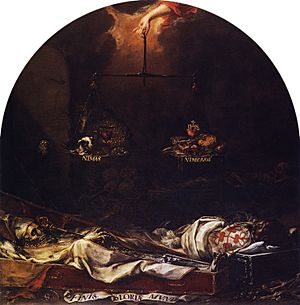In Ictu Oculi facts for kids
In Ictu Oculi means "In the blink of an eye" in Latin. It is a very large painting created by the Spanish artist Juan de Valdés Leal. He painted it between 1670 and 1672. This artwork was made for the Hospital de la Caridad in Seville, Spain. This hospital was a place for older people and a burial ground for those who were poor.
This painting is one of two similar artworks called "memento mori." These paintings remind us that life on Earth is short and that everyone will eventually die. The other painting is called Finis Gloriae Mundi. It shows the bodies of a bishop and a knight after death.
In Ictu Oculi features a scary figure of the grim reaper. This figure carries a coffin and a scythe. It stands over the remains of someone who was once powerful. Both paintings are still displayed near the entrance of the hospital. Many people think these are Valdés Leal's best works.
Why This Painting Was Made
In Ictu Oculi is one of two dramatic and chilling paintings by Valdés Leal. They were both created for the Hospital de la Caridad. The other painting, Finis Gloriae Mundi, shows the decaying bodies of a bishop and a knight. They are surrounded by symbols of their wealth and high status.
Both paintings are like allegories of death. An allegory is a story or image that has a hidden meaning. These artworks remind viewers that earthly life does not last forever. They also show that death comes to everyone, no matter how rich or powerful they are.
Valdés Leal called these works "hieroglyphs of our afterlife." This means they suggest that what matters most is salvation after death. This is more important than your position or wealth in this life. The paintings also suggest that salvation can only be achieved through charity. Helping others was the main mission of the church that asked for these paintings.
What the Painting Shows
The main figure in In Ictu Oculi is a skeleton, which represents death itself. This skeletal figure holds a coffin under one arm. It also carries a scythe, which is a tool with a long, curved blade. One foot of the skeleton rests on a globe, representing the world.
The skeleton stands in front of many items that symbolize wealth, power, and knowledge. These include:
- Scrolls and letters, showing learning.
- Jewelry, representing riches.
- A tiara, which is a type of crown, showing imperial power.
- Royal and religious robes made of purple and white velvet.
- Some weapons.
Death is shown putting out a candle. The candle represents how short life is. It shows that life can end "In the blink of an eye," just like the painting's title. Above the candle, there is a Latin phrase.
The painting also includes a book of designs by the artist Rubens. These designs were for arches built in Antwerp in 1634. They celebrated the arrival of a new Spanish governor. Including this book might show how people felt disappointed with politics at the time. The letters in the painting also warn that even fame from learning and science will be taken away by death.
See also
 In Spanish: In Ictu Oculi para niños
In Spanish: In Ictu Oculi para niños



